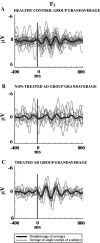Sensory evoked and event related oscillations in Alzheimer's disease: a short review
- PMID: 22132038
- PMCID: PMC2974091
- DOI: 10.1007/s11571-010-9138-5
Sensory evoked and event related oscillations in Alzheimer's disease: a short review
Abstract
Diagnosis and treatment of Alzheimer's disease (AD) depend on clinical evaluation and there is a strong need for an objective tool as a biomarker. Our group has investigated brain oscillatory responses in a small group of AD subjects. We found that the de novo (untreated) AD group differs from both the cholinergically-treated AD group and aged-matched healthy controls in theta and delta responses over left frontal-central areas after cognitive stimulation. On the contrary, the difference observed in AD groups upon a sensory visual stimulation includes response increase over primary or secondary visual sensorial areas compared to controls. These findings imply at least two different neural networks, depending on type of stimulation (i.e. cognitive or sensory). The default mode defined as activity in resting state in AD seems to be affected electrophysiologically. Coherences are also very valuable in observing the group differences, especially when a cognitive stimulus is applied. In healthy controls, higher coherence values are elicited after a cognitive stimulus than after a sensory task. Our findings support the notion of disconnectivity of cortico-cortical connections in AD. The differences in comparison of oscillatory responses upon sensory and cognitive stimulations and their role as a biomarker in AD await further investigation in series with a greater number of subjects.
Keywords: Alzheimer; Dementia; Event related; Oscillations; P300.
Figures






Similar articles
-
Increased long distance event-related gamma band connectivity in Alzheimer's disease.Neuroimage Clin. 2017 Mar 1;14:580-590. doi: 10.1016/j.nicl.2017.02.021. eCollection 2017. Neuroimage Clin. 2017. PMID: 28367402 Free PMC article.
-
Biomarkers in Alzheimer's disease with a special emphasis on event-related oscillatory responses.Suppl Clin Neurophysiol. 2013;62:237-73. doi: 10.1016/b978-0-7020-5307-8.00020-x. Suppl Clin Neurophysiol. 2013. PMID: 24053044 Review.
-
Evoked and event related coherence of Alzheimer patients manifest differentiation of sensory-cognitive networks.Brain Res. 2010 Oct 21;1357:79-90. doi: 10.1016/j.brainres.2010.08.054. Epub 2010 Aug 21. Brain Res. 2010. PMID: 20732310
-
A comparative analysis of sensory visual evoked oscillations with visual cognitive event related oscillations in Alzheimer's disease.Neurosci Lett. 2009 Oct 25;462(3):193-7. doi: 10.1016/j.neulet.2009.07.036. Epub 2009 Jul 16. Neurosci Lett. 2009. PMID: 19616074
-
Brain oscillations as biomarkers in neuropsychiatric disorders: following an interactive panel discussion and synopsis.Suppl Clin Neurophysiol. 2013;62:343-63. doi: 10.1016/b978-0-7020-5307-8.00016-8. Suppl Clin Neurophysiol. 2013. PMID: 24053048 Review.
Cited by
-
Brain Network Activation (BNA) reveals scopolamine-induced impairment of visual working memory.J Mol Neurosci. 2014 Sep;54(1):59-70. doi: 10.1007/s12031-014-0250-6. Epub 2014 Feb 18. J Mol Neurosci. 2014. PMID: 24535560 Clinical Trial.
-
Patients with mild cognitive impairment display reduced auditory event-related delta oscillatory responses.Behav Neurol. 2014;2014:268967. doi: 10.1155/2014/268967. Epub 2014 Mar 27. Behav Neurol. 2014. PMID: 24825953 Free PMC article.
-
Answering six questions in extracting children's mismatch negativity through combining wavelet decomposition and independent component analysis.Cogn Neurodyn. 2011 Nov;5(4):343-59. doi: 10.1007/s11571-011-9161-1. Epub 2011 Jun 28. Cogn Neurodyn. 2011. PMID: 23115592 Free PMC article.
-
A hybrid model for the neural representation of complex mental processing in the human brain.Cogn Neurodyn. 2013 Apr;7(2):89-103. doi: 10.1007/s11571-012-9220-2. Epub 2012 Sep 28. Cogn Neurodyn. 2013. PMID: 24427194 Free PMC article. Review.
-
Cholinergic modulation of event-related oscillations (ERO).Brain Res. 2014 Apr 22;1559:11-25. doi: 10.1016/j.brainres.2014.02.043. Epub 2014 Mar 2. Brain Res. 2014. PMID: 24594019 Free PMC article.
References
-
- Babiloni C, Binetti G, Cassetta E, et al. Mapping distributed sources of cortical rhythms in mild Alzheimer’s disease. A multicentric EEG study. Neuroimage. 2004;22(1):57–67. - PubMed
-
- Babiloni C, Binetti G, Cassetta E, et al. Sources of cortical rhythms change as a function of cognitive impairment in pathological aging: a multicenter study. Clin Neurophysiol. 2006;117(2):252–268. - PubMed
-
- Babiloni C, Vecchio F, Bultrini A, et al. Pre- and poststimulus alpha rhythms are related to conscious visual perception a high-resolution EEG study. Cereb Cortex. 2006;16)::1690–1700. - PubMed
-
- Babiloni C, Cassetta E, Dal Forno G, et al. Donepezil effects on sources of cortical rhythms in mild Alzheimer’s disease: responders vs. non-responders. Neuroimage. 2006;31(4):1650–1665. - PubMed
-
- Babiloni C, Cassetta E, Binetti G. Resting EEG sources correlate with attentional span in mild cognitive impairment and Alzheimer’s disease. Eur J Neurosci. 2007;25(12):3742–3757. - PubMed
LinkOut - more resources
Full Text Sources
Miscellaneous

